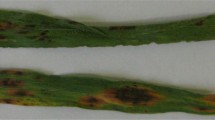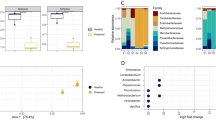Abstract
The aim of our study was to identify the causal agent of grey leaf spot disease of maize in southern Africa. Single-conidial cultures were recovered from maize leaves with typical disease symptoms sampled from several fields in South Africa, Zambia and Zimbabwe. Morphology, cultural characteristics, and a PCR-based test using Cercospora zeae-maydis and C. zeina-specific primer sets identified all single-conidial cultures as C. zeina. In addition, sequence alignment of DNA fragments of the internal transcribed spacer region (ITS1, ITS2, and the 5.8S gene) and elongation factor 1-α grouped all cultures in the same clade as the C. zeina ex-type culture CBS 118820. To by-pass cultivation of the slow-growing fungus, a rapid method to isolate DNA directly from lesions was successfully applied for PCR identification of C. zeina with species-specific ITS and histone primers. Koch’s postulates were fulfilled for C. zeina by artificially inoculating maize plants in a greenhouse, re-isolating conidia emerging from lesions and verifying pathogen identity with molecular techniques. These results provide evidence that confirms the presence of C. zeina and absence of C. zeae-maydis in commercial maize plantations in southern Africa.





Similar content being viewed by others
Abbreviations
- CI:
-
consistency index
- EF:
-
elongation factor 1-α
- GLS:
-
grey leaf spot
- ITS:
-
internal transcribed spacer
- RI:
-
retention index
References
Altschul, S. F., Gish, W., Miller, W., Myers, E. W., & Lipman, D. J. (1990). Basic alignment search tool. Journal of Molecular Biology, 215, 403–410.
Asea, G., Lipps, P. E., Pratt, R. C., Gordon, S. G., & Adipala, E. (2005). Development of greenhouse inoculation procedures for evaluation of partial resistance to Cercospora zeae-maydis in maize inbreds. Journal of Phytopathology, 153, 647–653. doi:10.1111/j.1439-0434.2005.01032.x.
Bair, W., & Ayers, J. E. (1986). Variability in isolates of Cercospora zeae-maydis. Phytopathology, 76, 129–132. doi:10.1094/Phyto-76-129.
Beckman, P. M., & Payne, G. A. (1982). External growth, penetration, and development of Cercospora zeae-maydis in corn leaves. Phytopathology, 72, 810–815. doi:10.1094/Phyto-72-810.
Beckman, P. M., & Payne, G. A. (1983). Cultural techniques and conditions influencing growth and sporulation of Cercospora zeae-maydis and lesion development in corn. Phytopathology, 73, 286–289. doi:10.1094/Phyto-73-286.
Carbone, I., & Kohn, L. M. (1999). A method for designing primer sets for speciation studies in filamentous ascomycetes. Mycologia, 91, 553–556. doi:10.2307/3761358.
Chakrabarti, R., & Schutt, C. E. (2001). The enhancement of PCR amplification by low molecular weight amides. Nucleic Acids Research, 29, 2377–2381. doi:10.1093/nar/29.11.2377.
Crous, P. W., Groenewald, J. Z., Groenewald, M., Caldwell, P., Braun, U., & Harrington, T. C. (2006). Species of Cercospora associated with grey leaf spot of maize. Studies in Mycology, 55, 189–197.
Dunkle, L. D., & Levy, M. (2000). Genetic relatedness of African and United States populations of Cercospora zeae-maydis. Phytopathology, 90, 486–490. doi:10.1094/PHYTO.2000.90.5.486.
Goodwin, S. B., Dunkle, D. L., & Zismann, V. L. (2001). Phylogenetic analysis of Cercospora and Mycosphaerella based on the internal transcribed spacer region of ribosomal DNA. Phytopathology, 91, 648–658. doi:10.1094/PHYTO.2001.91.7.648.
Griffith, G. W., & Shaw, D. S. (1998). Polymorphisms in Phytophthora infestans: Four Mitochondrial haplotypes are detected after PCR amplification of DNA from pure cultures or from host lesions. Applied and Environmental Microbiology, 64, 4007–4014.
Latterell, F. M., & Rossi, A. E. (1983). Gray leaf spot of corn: A disease on the move. Plant Disease, 67, 842–847. doi:10.1094/PD-67-842.
Möller, E. M., Bahnweg, G., Sandermann, H., & Geiger, H. H. (1992). A simple and efficient protocol for isolation of high molecular weight DNA from filament fungi. Nucleic Acids Research, 20, 6115–6116. doi:10.1093/nar/20.22.6115.
Nowell, D. C. (1997) Studies on ear rot and gray leaf spot of maize in South Africa. Dissertation, University of Natal
Okori, P., Fahleson, J., Rubaihayo, P. R., Adipala, E., & Dixelius, C. (2003). Assessment of genetic variation among East African Cercospora zeae-maydis. African Crop Science Journal, 11, 75–85.
Paul, P. A., & Munkvold, G. P. (2005). Influence of temperature and relative humidity on sporulation of Cercospora zeae-maydis and expansion of gray leaf spot lesions on maize leaves. Plant Disease, 89, 624–630. doi:10.1094/PD-89-0624.
Shim, W.-B., & Dunkle, D. L. (2005). Malazy, a degenerate, species-specific transposable element in Cercospora zeae-maydis. Mycologia, 97, 349–355. doi:10.3852/mycologia.97.2.349.
Swofford, D. L. (2002). PAUP*: Phylogenetic analysis using parsimony (*and other methods). Version 4.1b10. Sunderland, MA: Sinauer.
Tehon, L. R., & Daniels, E. (1925). Notes on parasitic fungi of Illinois. Mycologia, 17, 240–249. doi:10.2307/3753890.
Wang, J., Levy, M., & Dunkle, L. D. (1998). Sibling species of Cercospora associated with gray leaf spot of maize. Phytopathology, 88, 1269–1275. doi:10.1094/PHYTO.1998.88.12.1269.
Ward, J. M. J. (1996) Epidemiology and management of gray leaf spot: A new disease of maize in South Africa. Dissertation, University of Natal
Ward, J. M. J., Laing, M. D., & Cairns, A. L. P. (1997). Management practices to reduce gray leaf spot of maize. Crop Science, 37, 1257–1262.
Ward, J. M. J., Stromberg, E. L., Nowell, D. C., & Nutter Jr., F. W. (1999). Gray leaf spot. A disease of global importance in maize production. Plant Disease, 83, 884–895. doi:10.1094/PDIS.1999.83.10.884.
White, T. J., Bruns, T., Lee, S., & Taylor, J. (1990). Amplification and direct sequencing of fungal ribosomal RNA genes for phylogenetics. In M. A. Innis, D. H. Gelfand, J. J. Sninsky, & T. J. White (Eds.),PCR protocols: S guide to methods and applications (pp. 315–322). California: Academic.
Acknowledgements
We thank Martin Coetzee for assistance with the phylogenetic analysis. The funding of this work was provided by the Department of Science and Technology through the PlantBio Trust, South Africa and a Post-doctoral Fellowship from the University of Pretoria to BM.
Author information
Authors and Affiliations
Corresponding author
Rights and permissions
About this article
Cite this article
Meisel, B., Korsman, J., Kloppers, F.J. et al. Cercospora zeina is the causal agent of grey leaf spot disease of maize in southern Africa. Eur J Plant Pathol 124, 577–583 (2009). https://doi.org/10.1007/s10658-009-9443-1
Received:
Accepted:
Published:
Issue Date:
DOI: https://doi.org/10.1007/s10658-009-9443-1




